
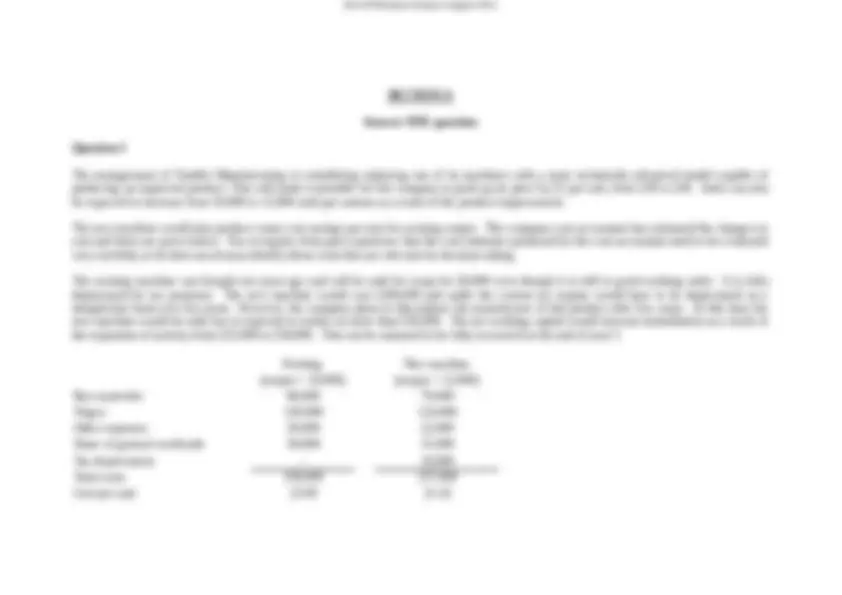
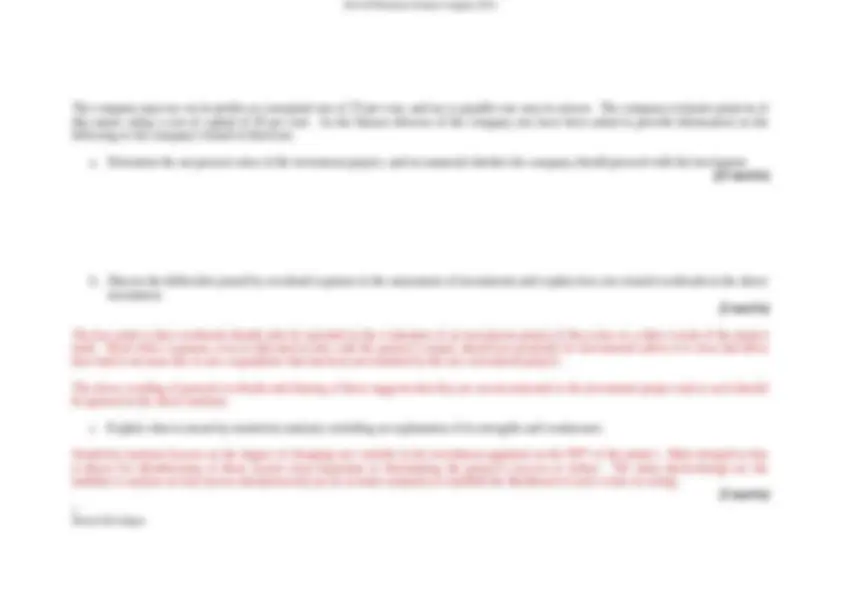
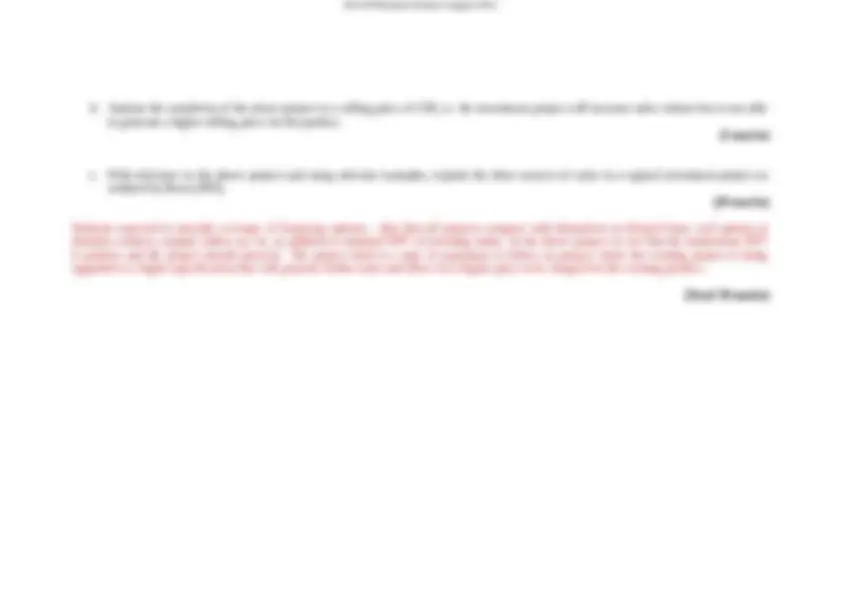
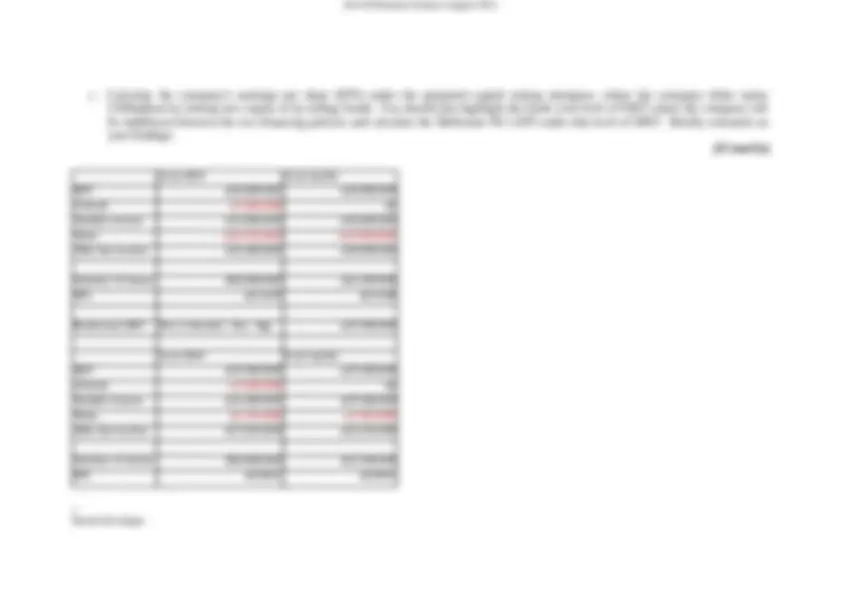
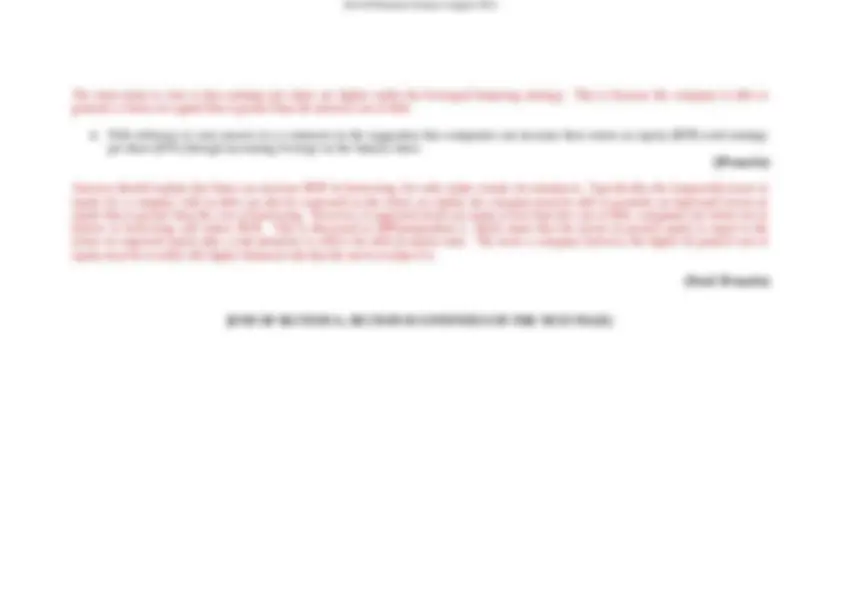
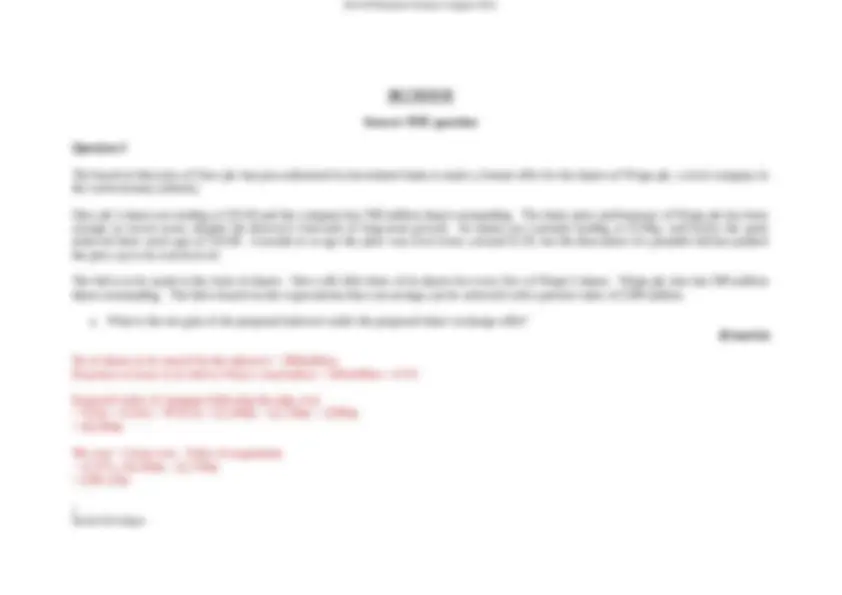
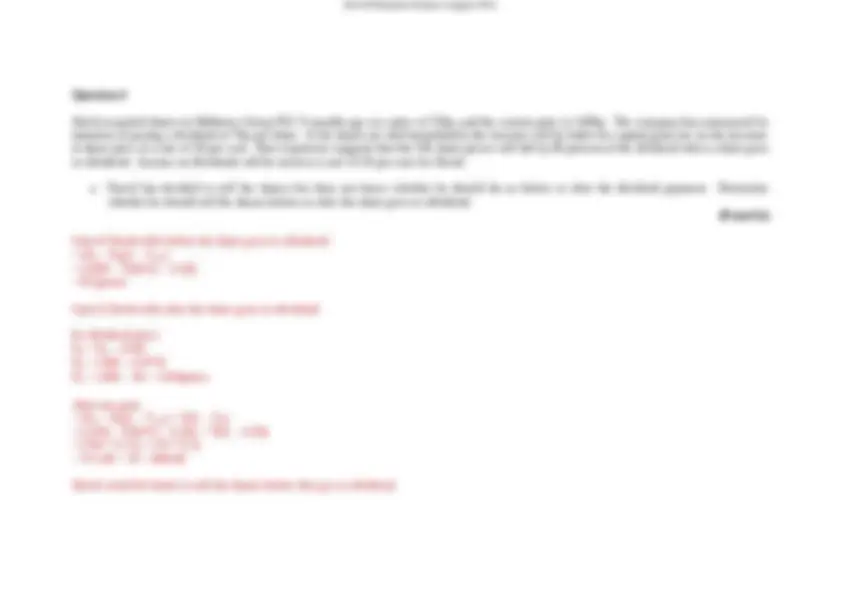
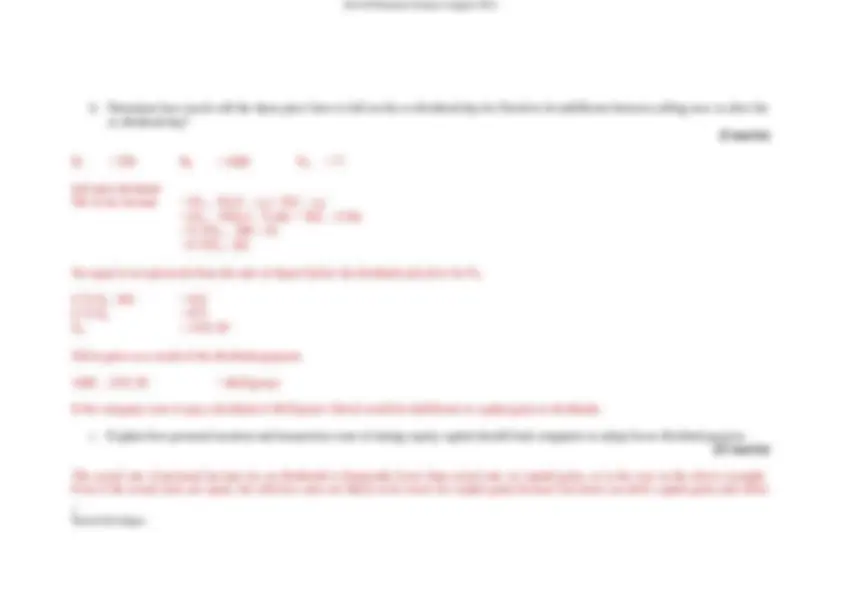
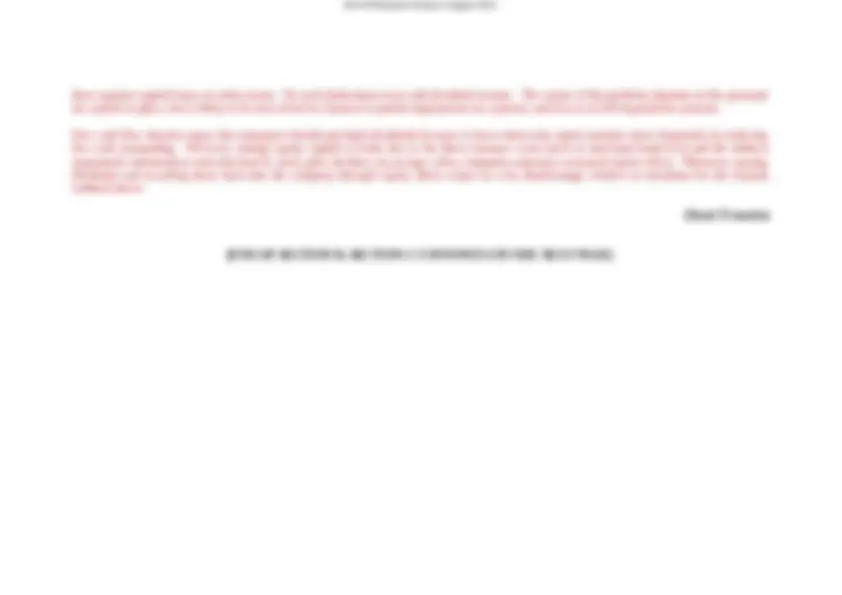








Study with the several resources on Docsity

Earn points by helping other students or get them with a premium plan


Prepare for your exams
Study with the several resources on Docsity

Earn points to download
Earn points by helping other students or get them with a premium plan
Community
Ask the community for help and clear up your study doubts
Discover the best universities in your country according to Docsity users
Free resources
Download our free guides on studying techniques, anxiety management strategies, and thesis advice from Docsity tutors
The august 2012 exam questions and solutions for the ag210 business finance course. The exam consists of three sections, each with one required question. Calculations and explanations for each question. It covers topics such as rights issues, earnings per share, takeovers, and the efficient markets hypothesis.
Typology: Exercises
1 / 23

This page cannot be seen from the preview
Don't miss anything!
















Calculators must not be used to store text and/or formulae nor be capable of communication. Invigilators may require calculators to be reset
1 Patrick McColgan
The company pays tax on its profits at a marginal rate of 25 per cent, and tax is payable one year in arrears. The company evaluates projects of this nature using a cost of capital of 20 per cent. As the finance director of the company you have been asked to provide information on the following to the company’s board of directors:
a. Determine the net present value of the investment project, and recommend whether the company should proceed with the investment. (25 marks)
b. Discuss the difficulties posed by overhead expenses in the assessment of investments and explain how you treated overheads in the above investment. (5 marks)
The key point is that overheads should only be included in the evaluation of an investment project if they arise as a direct result of the project itself. Head office expenses, even if allocated in line with the project’s output, should not generally be incremental unless it is clear that these have had to increase due to new expenditure that has been necessitated by the new investment project.
The above wording of general overheads and sharing of these suggests that they are not incremental to the investment project and as such should be ignored in the above analysis.
c. Explain what is meant by sensitivity analysis, including an explanation of its strengths and weaknesses.
Sensitivity analysis focuses on the impact of changing one variable in the investment appraisal on the NPV of the project. Main strength is that it allows for identification of those factors most important to determining the project’s success or failure. The main shortcomings are the inability to analyse several factors simultaneously (as in scenario analysis) or establish the likelihood of such events occurring. (5 marks)
1 Patrick McColgan
d. Analyse the sensitivity of the above project to a selling price of £38; i.e. the investment project will increase sales volume but is not able to generate a higher selling price for the product. (5 marks)
e. With reference to the above project and using relevant examples, explain the three sources of value in a typical investment project as outlined by Ross (1995). (10 marks)
Students expected to provide coverage of financing options – idea that all projects compete with themselves in delayed time; real options to abandon contract, expand, follow on, etc, in addition to standard NPV of investing today. In the above project we see that the stand-alone NPV is positive and the project should proceed. The project itself is a type of expansion or follow on project where the existing project is being upgraded to a higher specification that will generate further sales and allow for a higher price to be charged for the existing product.
(Total 50 marks)
b. Show that in principle the wealth of an investor who owns 80,000 shares prior to the issue will be unaffected by either subscribing to the rights, selling the rights nil-paid, or selling enough rights to fund the purchase of a maximum number of shares with no further cash investment (tail-swallowing). Briefly comment on your findings. (10 marks)
Investor owns 80,000 shares £160,000.
Can purchase 5 for 16 shares 25,
Take-up rights:
Investor owns 105,000 shares @ Px £200,
Cost of purchasing 25,000 new shares @ Ps -£40,
Net cost of por�olio £160,
Sell rights
Investor owns 80,000 shares @ Px £152,380.
Income from selling 25,000 rights @ Px - Ps £7,619.
Net cost of por�olio £160,
Tail swallowing:
Sell Y = (N* x Ps) / Px rights 21,
Take up N* - Y rights 4,
Investor owns 84,000 shares @ Px £160,000.
Sell rights to buy 21,000 shares @ Px - Ps £6,400.
Use proceeds to buy 4,000 shares @ Ps -£6,400.
Net cost of por�olio £160,000.
c. Calculate the company’s earnings per share (EPS) under the proposed capital raising strategies, where the company either raises £100million by issuing new equity or by selling bonds. You should also highlight the break even level of EBIT where the company will be indifferent between the two financing policies and calculate the McKenzie Plc’s EPS under this level of EBIT. Briefly comment on your findings. (12 marks)
Issue debt Issue equity EBIT £50,000,000 £50,000, Interest -£7,000,000 £ Taxable Income £43,000,000 £50,000, Taxes -£10,320,000 -£12,000, A�er-tax income £32,680,000 £38,000,
Number of shares 200,000,000 262,500, EPS £0.1634 £0.
Break-even EBIT (Nu x Interest) / (Nu - Ng) £29,400,
Issue debt Issue equity EBIT £29,400,000 £29,400, Interest -£7,000,000 £ Taxable Income £22,400,000 £29,400, Taxes -£5,376,000 -£7,056, A�er-tax income £17,024,000 £22,344,
Number of shares 200,000,000 262,500, EPS £0.0851 £0.
1 Patrick McColgan
Answer ONE question
Question 3
The board of directors of Oreo plc has just authorised its investment bank to make a formal offer for the shares of Wispa plc, a rival company in the confectionary industry.
Oreo plc’s shares are trading at £10.20 and the company has 500 million shares outstanding. The share price performance of Wispa plc has been average in recent years, despite the director’s forecasts of long-term growth. Its shares are currently trading at £5.90p, well below the peak achieved three years ago of £10.00. A month or so ago the price was even lower, around £5.50, but the discussion of a possible bid has pushed the price up to its current level.
The bid is to be made in the form of shares. Oreo will offer three of its shares for every five of Wispa’s shares. Wispa plc also has 500 million shares outstanding. The bid is based on the expectations that cost savings can be achieved with a present value of £500 million.
a. What is the net gain of the proposed takeover under the proposed share exchange offer? (6 marks)
No of shares to be issued for the takeover = 300million. Proportion of shares to be held by Wispa’s shareholders = 300m/800m = 0.
Expected value of company following the take over = V(O) + (V(W) + PV(CS) = £5,100m + £2,750m + £500m = £8,350m
Net cost = Gross cost – Value of acquisition = 0.375 x £8,350m - £2,750m = £381.25m
1 Patrick McColgan
Net gain = Gain – Net cost = £500m - £381.25million = £118.75million
b. Determine the impact of the takeover on the share price of Oreo Plc (2 marks)
Value of Oreo Plc based on £10.20 per share – price at pre-bid rumour
Price per share following takeover: £8,350/800 shares = £10.
Increase in share price of Oreo plc
c. As an alternative to the above, the board of Oreo plc has suggested that a £3billion cash offer may be a preferable alternative to both sets of shareholders. Calculate the net gain for Oreo plc under the cash offer and estimate the likely impact of the acquisition on Oreo’s stock price. (4 marks)
Net cost = Cash outlay – Value of target = £3,000m - £2,750m = £250m
Net gain = Gain – Net cost = £500m - £250m = £250million
Value of the combined company = £5,100m - £3,000m + £2,750m +£500m = £5,350m
Share price following the takeover = £5,350m / 500million shares = £10.
d. Explain the concerns faced by the managers of Oreo plc in using the current stock price of Wispa plc as a basis for offering a bid premium in the takeover.
Question 4
David acquired shares in Mulberry Group PLC 9 months ago at a price of 550p, and the current price is 1400p. The company has announced its intention of paying a dividend of 70p per share. If the shares are sold immediately the investor will be liable for capital gains tax on the increase in share price at a rate of 28 per cent. Past experience suggests that the UK share prices will fall by 80 percent of the dividend when a share goes ex-dividend. Income on dividends will be taxed at a rate of 50 per cent for David.
a. David has decided to sell the shares but does not know whether he should do so before or after the dividend payment. Determine whether he should sell the shares before or after the share goes ex-dividend. (8 marks)
Gain if David sells before the share goes ex-dividend: = (PB – P (^) 0)(1 – TCG) = (1400 – 550)*(1 – 0.28) = 612pence
Gain if David sells after the share goes ex-dividend:
Ex-dividend price: PX = PB – 0.8D PX = 1400 – 0.8* PX = 1400 – 56 = 1344pence
After-tax gain: = (PX – P0)(1 – T (^) CG) + D(1 – TE ) = (1344 – 550)*(1 – 0.28) + 70(1 – 0.50) = (794 * 0.72) + (70 * 0.5) = 571.68 + 35 = 606.
David would be better to sell the shares before they go ex-dividend.
b. Determine how much will the share price have to fall on the ex-dividend day for David to be indifferent between selling now or after the ex dividend day? (5 marks)
Sell after dividend Net of tax income = (PA – P0) (1 – t (^) g) + D(1 – t (^) p)
= (PA – 550) (1 – 0.28) + 70(1 – 0.50) = 0.72PA – 396 + 35 = 0.72PA - 361
Set equal to net proceeds from the sale of shares before the dividend and solve for PA
Fall in price as a result of the dividend payment
1400 – 1351.39 = 48.61pence
If the company were to pay a dividend of 48.61pence David would be indifferent to capital gains or dividends.
c. Explain how personal taxation and transaction costs of raising equity capital should lead companies to adopt lower dividend payouts. (12 marks)
The actual rate of personal income tax on dividends is frequently lower than actual rate on capital gains, as is the case in the above example. Even if the actual rates are equal, the effective rates are likely to be lower for capital gains because investors can defer capital gains and offset
1 Patrick McColgan
Answer ONE question
Question 5
Explain what is meant by the efficient markets hypothesis (EMH); its main forms, and its implications for corporate financial managers. (25 marks)
Market efficiency states that the price of a security is the present value of all future cash flows. When information is released it is immediately reflect in a company’s stock price, which means that knowing information when it is released does an investor no good.
Three main forms of market efficiency are weak form; semi-strong form; and strong form efficiency. These differ in terms of what is meant by all available information. Under weak form the information set includes past information; semi-strong form includes past and all publicly available information; and strong form includes the privately held information in addition to the previous.
The implications for financial managers are that accounting choice has no impact on firm value, that managers cannot time security issuance decisions, there are no price pressure effects from security issuance, and that managers and investors can trust financial markets.
Question 6
Comment on the following in relation to leasing assets:
a. Distinguish between operating leases and financial leases and explain the type of assets that are expected to be leased under both types of contract. (10 marks)
Operating leases are shorter term, and tend to be for a shorter period than the expected useful life of the asset, the lessor is required to maintain the asset, and the lessee has the option to cancel the contract. Assets leased tend to include computer equipment, plant hire equipment, cars, photocopiers, etc.
1 Patrick McColgan
Financing leases tend to be longer term and for the full economic life of the asset. The lessor does not generally maintain or service the asset, the lessee does not generally have the option to cancel the contract but does have the ability to extend the contract on expiration. Financing leases are more of a direct alternative to borrowing to purchase the asset. Assets leased tend to include plant and large machinery such as aeroplanes.
b. Critically evaluate the following reasons for leasing an asset and explain whether they are most applicable to operating or finance leases:
b.i. Maintenance of the leased asset. (5 marks)
Operating leases typically require the lessor to maintain the asset. This is a cost that would otherwise be borne by the lessee were they to purchase the asset. Under perfect markets this would not provide an incentive to enter into the lease contract. However, there are generally economies of scale in the cost of maintaining and purchasing spare parts for machinery for the lessor relative to the lessee that would allow them to reduce the lease payment and produce a net advantage to leasing for both parties.
b.ii. Transaction costs in purchasing the asset. (5 marks)
Operating leases. Transaction costs in the purchase and sale of assets for a short-term lease typically make operating leases attractive. For example, if a builder were to need the use of a mechanical digger for one week to dig the foundations for a home, they could either purchase the asset or lease it. Purchasing would necessitate the subsequent sale of the asset and incur a transaction cost through the spread charged by a dealer of these assets. An operating lease negates this transaction cost.
b.iii. Reducing reported debt on the company’s balance sheet. (5 marks)
Financing leases. Companies historically have tried to use financing leases to hide debt in the footnotes to the financial statements with the objective of reducing the apparent leverage of the business and making it appear less risky than it truly is. Entering into a finance lease avoids the immediate requirement to borrow to fund the purchase price of the asset. However, under IFRS 17 firms must show the capitalised value of
Table A-1 Future Value of £1 at the end of n periods = (1+r)n